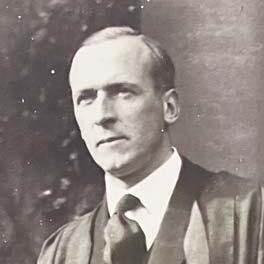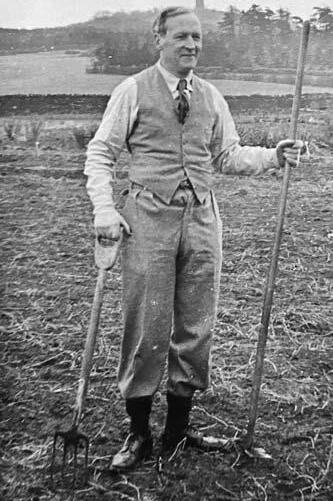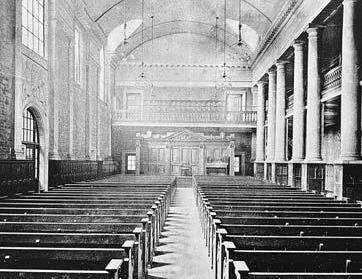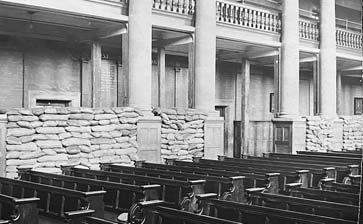
5 minute read
A HISTORY OF THE RGS IN ITS PEOPLE
ER THOMAS OBE (STAFF 22-48)
BY DAVID GOLDWATER (51-62)
Advertisement
Just over 100 years ago, in January 1922, the RGS Governors appointed Dr Ebenezer Rhys Thomas as new Headmaster, following the departure of John Talbot (Staff 12-21) to Haileybury College in Hertfordshire. Talbot had led the school throughout the First World War, during which he served in the Northumberland Fusiliers as a Major.

His successor, Ebenezer Thomas was born on 10 April 1885 in Aberystwyth, Cardiganshire. He was to serve RGS for 26 years. ‘ERT’ or ‘Eb’ as he was popularly known, led the school during the period following the Great War and through the Second World War, stewarding many of the massive changes which we can still see today. He strengthened the Sixth Form from a very weak position with exam results improving enormously. He appointed teachers of great distinction, including the Anatole Theakstone (Staff 1925-61) and Louis Theakstone (Staff 193238 & 1946-53 – army service intervening), brothers brought up in St. Petersburg and pre-revolution students at Moscow University. Music at the school developed positively after Thomas appointed Arthur Milner (Staff 27-48) as Head of Music in 1927 and drama began its development after the school theatre was built in 1930. A full article on Mr Milner can be found in ONA Magazine Issue 98.
The school’s extracurricular activities were most significant in the growth of school camps, which were eventually to become such a major feature of the second half of the century. Michael Roberts (Staff 1925-31 & 34-41) was one of ERT’s most extraordinary appointments and is the subject of an article in ONA Magazine Issue 91 in Summer 2014 available here.
ER Thomas instituted parents’ conferences and the good relationships which he fostered with parents undoubtedly helped them to accept the harsh separation of the evacuation to Penrith from 1939 to 1944. The Headmaster, who was himself very keen on working on the school allotments in Penrith to help “Dig for Victory,” encouraged the boys who stayed in Penrith over the summer to volunteer and get involved. The band of Penrith ‘survivors’ will remember the allotment field lay to the East of Beacon Road and despite being full of couch weed, was divided into working plots.

Another of Thomas’ innovations, and his link with our technology theme in this edition, was the introduction of BBC School Broadcasting at RGS, commented on very positively by an American writer visiting in the 1930’s.
He was educated at Aberystwyth School and University College there. He was Tutor and Head of Science at Rugby School from 1912-21, during which time he served in France in the Royal Warwickshire Regiment, where he was mentioned in dispatches. After further military service in the UK, he answered the call from the RGS Governors at the end of 1921. Within a year of commencing his Headship in Newcastle, he must have felt secure enough to propose marriage to Dr Mary (Molly) Foster Richardson, 12 years his junior. She was born on 14 June 1897 in Sedbergh, Cumbria and died in 1956 at age 59. She was educated at Bootham’s sister school, The Mount, in York. They were married on 21 June 1923 in the Friends Meeting House, Newcastle.
The school grew physically under ERT’s headship, with the provision of several new buildings, some of which have only recently been replaced, as well as those remaining today. The changes referred to under ERT’s headship were largely funded through the generosity of Old Novo Sir Arthur Munro Sutherland (ON 1878-83), governor from 1919 and Chairman of Governors from 1929 until his death in 1953. He was, by far, the most munificent benefactor the school has ever had. One of his and Lady Sutherland’s most iconic gifts was the Binns Organ which has dominated the south end of the School Hall for 99 years. Plans are in hand to commemorate its inauguration with a tribute in the next edition of ONA Magazine
They had three sons, all attending the RGS: Peter Daniel Spence Thomas (3342), Ioan Foster Thomas (35-45), Donald Birket Thomas (37-48).
The Richardsons were a prominent local Quaker family and Molly’s father Hugh Richardson farmed at Wheel Birks (now Wheelbirks) in Stocksfield, which the family still own, as they have done since 1882. Hugh had originally been a schoolmaster and in October 1927, it was noted: at the annual meeting of the N.E. Branch of the Science Masters’ Association, at the Royal Grammar School, Newcastle: Mr Hugh Richardson, M.A., exhibited an extensive series of experiments illustrating osmosis, colloids and diffusion, and many other experiments were shown by the members in general. So here was the RGS Headmaster hosting his father-inlaw, once an educator himself, now a successful farmer.
Dr Thomas was awarded an OBE in 1941. Retiring in 1948 at the age of 63, he accepted a part-time lectureship in the Department of Engineering at King’s College, Newcastle. He died in Harrogate in 1979 at the age of 94.
A further Richardson connection: in Spring 2018, an article appeared in ONA Magazine about the School Observatory, with its impressive 4.5 inch refractor telescope which used to stand at the north end of the school field. This was the gift of Laurence Richardson, amateur astronomer, educated at the Quaker Bootham School, who lived in Rye Hill. The instrument was made by Cooke and Sons of York, another of whose telescopes was at Bootham.
Some personal recollections of ‘Eb’ by Old Novos
Bill Peacock (45-50)
From my lowly perspective it was difficult to form any opinion save that he was, rightly, respected. As evidence of this and an occurrence which is as clear a memory to me today as it was when it happened was the assembly –and in front of all pupils and masters –he tripped over his academic gown while mounting the platform and took a heavy fall. I would think that in this day and age titters would be heard but such was the respect and concern that all held for an outstanding man, there was stunned silence.
Joseph Fisher (30-36)
My recollection of ERT: Sharp features, stern, little sense of humour and unapproachable to a 13 year old. Would that be him?!
Burland Jacob (44-49)
During the 2019 School Carol Service, the Headmaster Geoffrey Stanford, performed on the French Horn. This reminded me of my first Head, Dr Thomas, who played the cello in the First Orchestra. His nickname was ‘Ebb’ and his wife ‘Flo’.
Dr Stanley Ashman (41-50)
A charismatic Welshman who when entering a room, there was silence. I recall him not allowing George Dean (Staff 1924-67) to smoke anywhere in school and had to go onto the playing field.
Bryan Stevens (Staff
44-49)
Although a disciplinarian, ERT adopted effective ploys when establishing the norms of schoolboy behaviour. His seldomly used cane was more usually replaced by a letter to the parents, via the culprit, to explain or excuse the offence. After hymns and prayers in the morning, the regular warning not to walk on the waterlogged school field would be rigidly obeyed. ERT laid great emphasis on the history of the school and established the house system, the school crest (paid for by Arthur Munro Sutherland, of course). His early schooldays had coincided with the closing days of Queen Victoria’s reign and he laid great emphasis on an allround education, hence there was a General Science period for the Arts Vl and English for the scientists. He himself was an active scientist, but with a deep interest in literature and drama. He also was the real founder of the School’s musical heritage, especially with the appointment of Arthur Milner (Staff 26-48) as the Head of Music. Dr Thomas was a player as well as a keen listener. A great walker, especially during the war years at Penrith, and later he would walk to school each day from his home in Belle Grove Terrace, Spital Tongues.
Sandbags in the Main Hall, 1939 Main Hall without the Binns Organ ER Thomas with the 1921-22 rugby 1st XV











